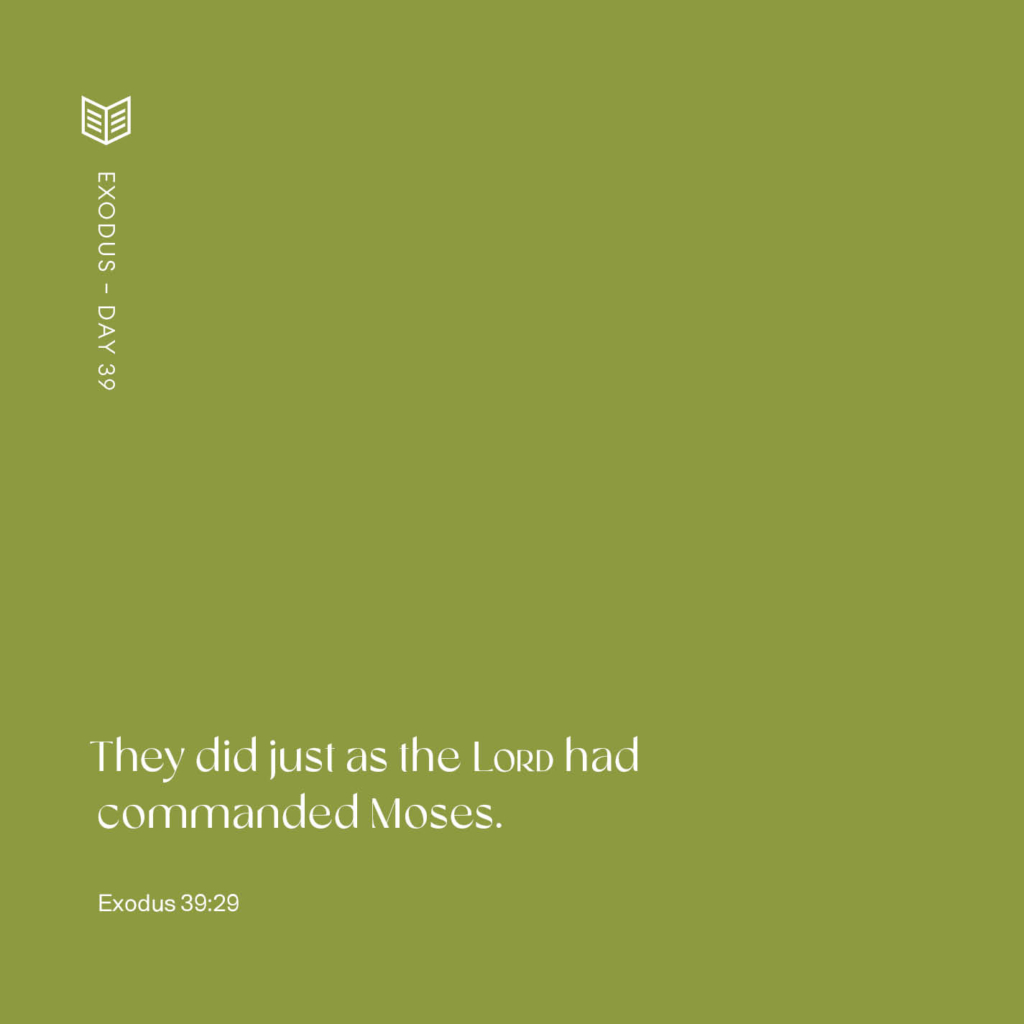Making the Priestly Garments
Open Your Bible
Exodus 39:1-43, Psalm 110:1-4, Hebrews 5:1-10
BY Erin Davis
I believe with all my heart that these detailed descriptions of the construction of the tabernacle in Exodus are as much the inspired Word of God as my favorite psalm. But for a free-spirited, color-outside-the-lines kind of girl like me, the sheer number of details recorded in these chapters gives me flashbacks to my freshman accounting class.
Why did the Lord instruct Moses to build altars and tables, lampstands and basins, tunics and turbans with such extreme attention to detail? Why were these details recorded so meticulously? All these centuries later, what do they have to teach us about the character of God and our relationship with Him?
Let’s zero in for a moment on Exodus 39, where we find the description of the priestly garments. This was more than a garment. With gold and stones, bells and crowns, this was an ensemble made to take our breath away. But why? Aaron’s robes weren’t designed to turn heads at Fashion Week. They wouldn’t be sold to the highest bidder. So why was such detailed extravagance needed?
Peel away the layers, and we find the answer in a single thread. The scarlet thread mentioned over and over in Exodus 39 is the same thread that is stitched throughout all of God’s Word. It is the thread God used to sew together garments of grace for Adam and Eve after the fall (Genesis 3:21). It is the thread that signaled salvation from Rahab’s window (Joshua 2:18). And most significantly, we see it at the cross, as trails of blood stream down our Savior’s face as evidence of His atonement for our sins.
Aaron’s priestly garments were woven with red thread, a picture of the gospel illustrated by the thread of salvation woven throughout all of God’s Word. The weight of the robe covered with stones was symbolic of the burden of sin; as Aaron slipped it on, I imagine its heaviness reminded him of the weight of his own sin and of ours. The crown on the priest’s head was a shadow of the crown of salvation purchased for us at Christ’s cross.
The garment maker couldn’t have known it, but he was preaching the gospel. Stitch by meticulous stitch, he was proclaiming salvation was near. Through the lens of the cross we see these extravagant robes showcase an extravagant gospel.
It’s possible the craftsmen tasked with the minutiae of the tabernacle felt overwhelmed and even belabored by the tedium of so many details. Obedience can often feel like that. As we shepherd our own children, or serve in other often thankless ways, or pull out our Bibles listening for God’s voice again and again, there are times when we all wonder, Why does all of this matter?
The answer rarely seems to come in the moment, but in hindsight we see that routine obedience to the Lord always reveals the gospel thread. He is using our seemingly small acts of surrender to transform these filthy rags into robes of righteousness. As we trust and obey, we can look back and sigh with gratitude saying we have “done just as the LORD commanded” (Exodus 39:43).

34 thoughts on "Making the Priestly Garments"
-
❤️
-
Tina, I love this! Thank you for sharing your story with us.
Michelle P- praying for you as you lead and intercede for others. That you do not grow weary and remember that Jesus is there, interceding for you <3. Praying that God covers all your needs: a new job, a fixed car and new home. -
@ JENNIFER LOVES JESUS
Thank you for your meditation on the bells and pomegranates. I love the questions that you pose. I want to ask that of myself. What do people hear? What taste do I leave?
I also love how you linked the bells to intercession. What a great reminder and encouragement that are prayers and intercession matter to God and are beautiful in His sight.
Thank you.
-
@KRISTEN
Thank you for sharing this gem from R. C. Sproul. What wonderful teaching!
-
This plan has been so crucial to my life. Every day, the Lord has been showing me parallels to my own story with Moses.
I have needed it. It can be lonely to be a leader, at the top of the mountain. You look down and see the people and intercede for them, daily. You care so deeply you put your own life on the line for them in ways they can’t and won’t ever see.
I have to learn how to not expect the intercession in return. That sometimes, as a Christian, you serve and love people so deeply that don’t have it in them to return the favor.
It hurts. Man. It hurts because sometimes it’s the people you expect it from, that don’t love you the way you need to be loved.
Moses had a hard job.
I can relate to him in some ways, but in some ways, I’m thankful I’m not called to lead a rebellious people for the last 40 years of my life. Lol.
My heart is grieving the loss of intimacy I’ve experienced the past few years. Constantly giving my heart away to only learn they aren’t going to care for it the way I need them to. I have taken some time to be with God on the mountain and I feel it all.
Though, I celebrate the victory of this season. The seeds I planted and helped God care for . But I so desperately need to let it all go and move on. I did my job. Now, I trust God to let me pray from afar.
I’m praying for a new job. God told me I’ll be moving soon. I have no money saved. My car is in the shop. I can’t work because I use my car for work.
Here on the mountain, I feel it all.
-
Thanks for sharing Tina! I have often too held on to the fact that I never felt good enough. Gods glory is really divine and I’m glad you can see gosh now.
-
As I was reading the scripture I was thinking to myself, “the men who were priest had to be stout, sturdy, well built, strong men, especially the head priest, because of the weight of all that was on the garments.” But unlike Erin, I failed to think of the significance of the weight of the garments. I love her analogy of the different parts of the garments.
My sister is getting out of rehab today.
Sisters, be blessed and ALWAYS trust and obey God.
-
Erin wrote about the garments of grace made for Adam and Eve. I just heard a teaching by R C Sproul. In one part he talked about metaphors/anolgies in the Bible that talk about imputation as described as a covering. He says that it starts in Genesis. Right after the fall they looked for coverings, because they felt the first human experience of guilt. This was a profound experience of shame of an acute awareness of walking around without any clothes on. Adam was hiding. The very first act of redemption was God in His mercy, came down and made clothes and covered their nakedness. He said every time we see someone with clothing, or put on our own clothes we should think about the first piece and the mercy of God that we don’t have to parade around our shame to the world. Then he talks about the day of atonement and the elaborate instructions are given. The priest had to get animals and their blood is taken into the Holy of Holies. The blood is sprinkled on the mercy seat between the cherubim which indicates God’s throne, before which we are all guilty. The priest under God’s instruction covers the mercy seat symbolizing our covering. Then, there is the scapegoat. The sins are transferred symbolically to the goat which is driven out symbolizing the removal of sin. ThIs blood could never be enough but pointing to the only One that could truly save! We are covered by Him. ( I’m paraphrasing.) What an amazing merciful God and a beautiful, wonderful Savior! May we never take Your mercy and Sacrifice lightly! Praise to Him always and forever! Amen!



Post Comments (34)